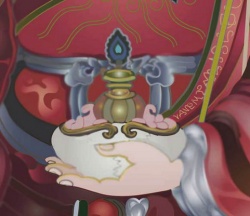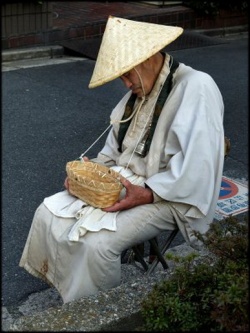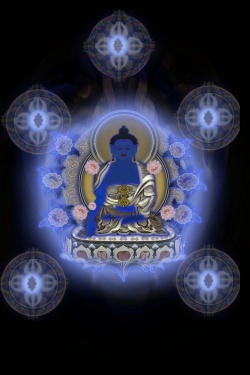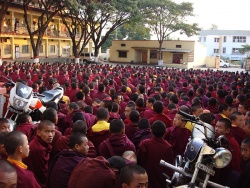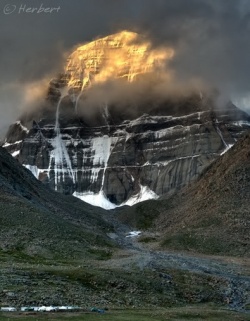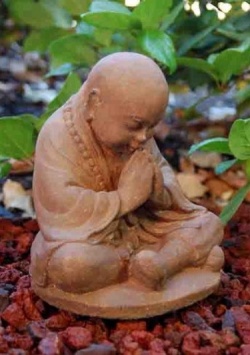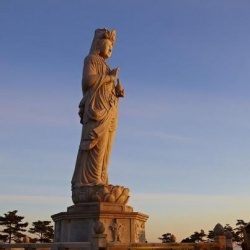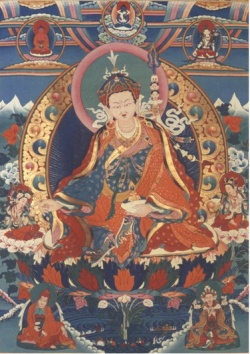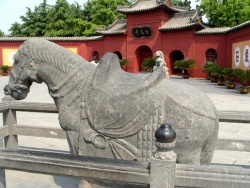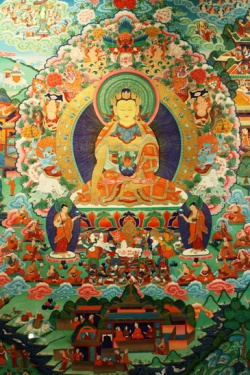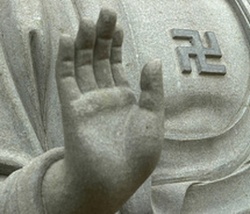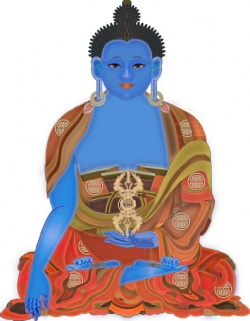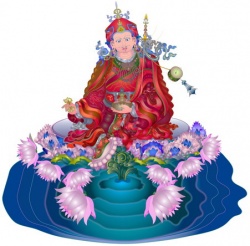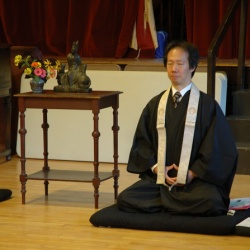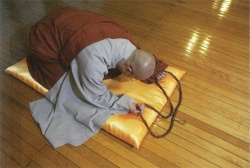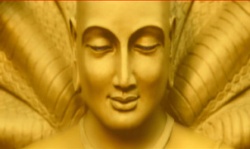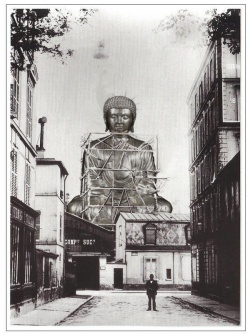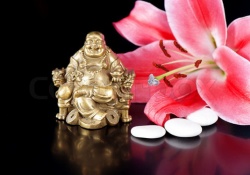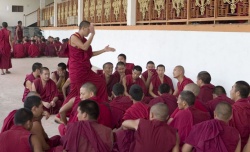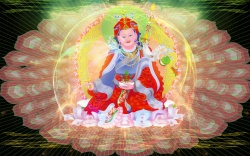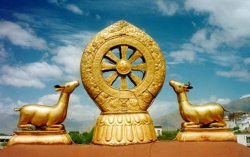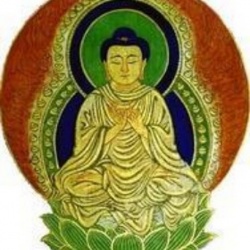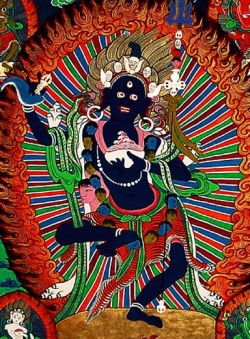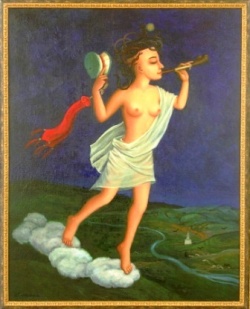Difference between revisions of "The Higher Teachings"
(Created page with "<poem> You may already have encountered the terms Lam Rim, Lam Dre, Dzogchen, Mahamudra and Maha Ati. These are the designations of systems or methods, [...") |
m (Text replacement - "]]]" to "]])") |
||
| (10 intermediate revisions by 4 users not shown) | |||
| Line 1: | Line 1: | ||
| − | <poem> | + | <nomobile>{{DisplayImages|1619|949|1672|2424|1320|1111|2682|3000|2636|1578|3560|618|1313|3165|1866|635|2041|1595|2291|4499|1279|3937|3237|798|1617}}</nomobile> |
| − | You may already have encountered the terms [[Lam Rim]], [[Lam Dre]], [[Dzogchen]], [[Mahamudra]] and [[Maha Ati]]. These are the designations of systems or methods, [[views]] or attitudes that are [[characteristic]] of various [[schools of Tibetan Buddhism]]. | + | |
| + | |||
| + | |||
| + | <poem> | ||
| + | You may already have encountered the terms [[Lam Rim]], [[Lam Dre]], [[Dzogchen]], [[Mahamudra]] and [[Maha Ati]]. | ||
| + | |||
| + | These are the designations of systems or methods, [[views]] or attitudes that are [[characteristic]] of various [[schools of Tibetan Buddhism]]. | ||
[[Lam Rim]] | [[Lam Rim]] | ||
| − | The first, the [[Lam Rim]] teachings, comprise a graduated [[path]] to [[wisdom]] that is usually associated with the [[Gelugpas]], but is used by all [[schools of Tibetan Buddhism]] and, since it refers to a [[gradual]] and ordered system, is the method used in almost all the world's [[Buddhist traditions]] in one [[form]] or another. The sect to which HH [[Dalai Lama]] belongs calls [[Tsong Khapa's]] great text, known as the Great [[Lam Rim]] ([[Lam Rim]] Chenmo) "the definitive teachings on the [[Path]] to [[Enlightenment]]." | + | The first, the [[Lam Rim]] teachings, comprise a graduated [[path]] to [[wisdom]] that is usually associated with the [[Gelugpas]], but is used by all [[schools of Tibetan Buddhism]] and, since it refers to a [[gradual]] and ordered system, is the method used in almost all the world's [[Buddhist traditions]] in one [[form]] or another. |
| + | |||
| + | The [[sect]] to which HH [[Dalai Lama]] belongs calls [[Tsong Khapa's]] great text, known as the Great [[Lam Rim]] ([[Lam Rim]] Chenmo) "the [[definitive teachings]] on the [[Path]] to [[Enlightenment]]." | ||
| + | |||
[[Lam Dre]] | [[Lam Dre]] | ||
| + | |||
The [[Sakyapa]] [[path]] is called [[Lam Dre]], The [[Path]] and Its Fruit. | The [[Sakyapa]] [[path]] is called [[Lam Dre]], The [[Path]] and Its Fruit. | ||
| − | The other three terms Maha-ati, [[Dzogchen]] and [[Mahamudra]]e really only two. The refer to practices that teach the way of directly experiencing the [[true nature]] of [[consciousness]] -- what is usually called "[[Mind]]." Maha-ati is [[Sanskrit]] for the [[Tibetan]] expression, [[Dzogchen]], a a term generally associated with [[Nyingmapas]]. | + | The other three terms [[Maha-ati]], [[Dzogchen]] and [[Mahamudra]]e really only two. |
| + | |||
| + | The refer to practices that teach the way of directly experiencing the [[true nature]] of [[consciousness]] -- what is usually called "[[Mind]]." [[Maha-ati]] is [[Sanskrit]] for the [[Tibetan]] expression, [[Dzogchen]], a a term generally associated with [[Nyingmapas]]. | ||
| + | |||
| + | |||
[[Mahamudra]] | [[Mahamudra]] | ||
| − | [[Mahamudra]] is [[Sanskrit]] for the [[Tibetan]] Chagchen (spelled phyag-rgya-chen -po, or -mo) associated with the [[Kagyu]]. In the [[prayers]] that accompany the [[ngondro]] or "[[extraordinary]] [[preliminary practices]]," we pray to achieve the [[fruition]] of our practices, [[Mahamudra]]. | + | |
| + | [[Mahamudra]] is [[Sanskrit]] for the [[Tibetan]] [[Chagchen]] (spelled phyag-rgya-chen -po, or -mo) associated with the [[Kagyu]]. In the [[prayers]] that accompany the [[ngondro]] or "[[extraordinary]] [[preliminary practices]]," we pray to achieve the [[fruition]] of our practices, [[Mahamudra]]. | ||
[[Mahamudra]] is like being immersed in the ocean, while [[Maha Ati]] is like looking over the expanse of that ocean. | [[Mahamudra]] is like being immersed in the ocean, while [[Maha Ati]] is like looking over the expanse of that ocean. | ||
| − | |||
| − | |||
| − | "Being free from mind-productions, it is the Mahamudra. Free from extremes, it is the great Madhyamika. Since it is the consummation of everything, it is called the Great [Maha] | + | The two approaches may have first been [[taught]] as a combination by the [[First Chagme Rinpoche]] (17th-century.) |
| + | |||
| + | However, their connection was fully understood at least by the [[time]] of the [[Third Karmapa]], [[Rangjung Dorje]] (1284-1339) for, in the [[Aspiration]] [[Prayer]] of [[Mahamudra]], he says, | ||
| + | |||
| + | "Being free from mind-productions, it is the [[Mahamudra]]. Free from [[extremes]], it is the great [[Madhyamika]]. Since it is the consummation of everything, it is called the Great [[Maha Ati]]. May I have the [[confidence]] that, by [[understanding]] one, all are [[realized]]." | ||
| + | |||
| + | The "it" which [[Karmapa]] [[Rangjung Dorje]] refers to is the [[Wikipedia:Absolute (philosophy)|ultimate]] [[nature]] of the [[mind]]. | ||
| + | |||
| + | Note that [[Karmapa]] considers the [[philosophical]] [[realization]] of [[Emptiness]] known as [[Madhyamika]], as also leading to [[realization]] of that [[nature]]. | ||
| + | |||
| + | [[His Eminence]] [[Jamgon]] [[Tai Situ Rinpoche]] reiterates that in his commentary on [[Karmapa]] [[Rangjung Dorje's]] The [[Aspiration]] [[Prayer]] of [[Mahamudra]], the [[Definitive Meaning]] mentioned above. ([[Shenpen Osel]]: That on-line journal has a number of teachings on [[Mahamudra]]. See vol. 3, 2000 especially.) | ||
| + | |||
| + | "[[Karmapa]] says, being [[beyond]] any kind of {{Wiki|conceptual}} limitation is [[Mahamudra]]. | ||
| + | |||
| + | Being [[beyond]] any kind of extreme like [[nihilism]], {{Wiki|eternalism}}, etc. is the [[middle way]], the Great [[Middle Way]]. The [[essence]] of all together, the {{Wiki|unity}} of everything, is called the great [[completeness]], [[Dzogchen]]. | ||
| − | + | Then he says, by [[knowing]] any one of these, one realizes the [[essence]] of everything." | |
| − | |||
| − | + | [[Dzogchen]] and [[Mahamudra]] can both be [[taught]] as a progression of Ground, [[Path]], and [[Fruition]]. | |
| − | + | Ground establishes the [[view]] and includes [[information]] including {{Wiki|principles}} which we can use for orientation; [[Path]] involves the implementation of Ground and may refer to specific [[meditation]] techniques, and [[Fruition]] is the result of the [[Path]] -- in the case of [[Mahamudra]] and [[Maha-Ati]], it is [[Enlightenment]]. | |
| − | Mahamudra is taught in all the Kagyu lineages, and in the Gelug lineage as well. | + | [[Mahamudra]] is [[taught]] in all the [[Kagyu]] [[lineages]], and in the [[Gelug lineage]] as well. |
| − | + | [[Dzogchen]] is primarily a [[Nyingma practice]] but many [[teachers]], eg. [[Dzogchen Ponlop Rinpoche]], are fully qualified to teach either. | |
| − | Dzogchen | + | Also, On the Union of [[Mahamudra]] and [[Dzogchen]] is a popular topic of public {{Wiki|discourse}}. |
| − | |||
| − | + | Both practices have relatively easy to understand instructions but [[books]] are not much help. | |
| − | The | + | The genuine application of these practices require a qualified guide, and there really is the necessity for the special [[transmission]] and "pointing out instructions" to be given by a qualified [[person]]. |
| − | |||
| − | |||
| − | |||
| − | + | [[Dzogchen]] | |
| − | |||
| − | + | The [[Guhyagarbha]] [[tantric]] [[tradition]] holds that the [[Dzogchen]] (or [[Dzokchen]]) teachings were introduced by fully [[awakened]] [[beings]] to the [[Wikipedia:Sage (sophos|sage]] [[Vimalakirti]], and then codified by [[King]] [[Dza of Uddiyana]], the region where [[Padmasambhava]] appeared. | |
| − | + | In the [[form]] of that [[tantra]], the method was passed by the [[yogi]] [[Kukkuraja]] to [[Sri Pramodavajra]] (Tib. [[Garab Dorje]],) who at that [[time]] (ca. 775 CE) was a [[Buddhist monk]]. | |
| − | Alex Wilding, in response to a question, to the Kagyu email list, Sept. 3, 2007: | + | Accomplishing full [[realization]], [[Garab Dorje]] as a wandering [[yogi]] then [[taught]] [[mahapandita]] (great expert) [[Manjushrimitra]], of [[Nalanda University]] in central [[India]]. |
| + | |||
| + | Later, both [[yogis]] [[taught]] at the [[great stupa]] of [[Shankarakuta]]. | ||
| + | |||
| + | |||
| + | The [[essence]] of this [[non-dual]] (Skt. [[advaita]]) approach is, that through the pointing out instructions of an [[empowered]], [[experienced]] [[Dzogchen]] [[teacher]], one can be | ||
| + | |||
| + | |||
| + | 1. directly introduced to one's [[own]] [[nature]] which is not different from the [[Dharmakaya]]; | ||
| + | 2. directly [[recognize]] (Skt. [[pratyabhijna]]) that singular [[state]], and | ||
| + | 3. through this [[experience]], directly immerse in it by means of [[faith]] in [[Liberation]]. | ||
| + | |||
| + | |||
| + | [[Nyoshul Khenpo]] in Natural [[Great Perfection]]: Teachings on [[Dzogchen]] holds that [[experience]] is a [[function]] of the "creative [[energy]] of the ground [[state of being]]" or the [[dharmakaya]]. | ||
| + | |||
| + | [[Traleg Rinpoche]] who is a [[Kagyupa]] said, in a [[teaching]] about [[Dzogchen]], that [[Mahamudra]] and [[Dzogchen]] are the same since both say that the [[dharmakaya]], [[sambogakaya]] and [[nirmanakaya]] are {{Wiki|present}} in everyone, and not only in [[buddhas]]. | ||
| + | |||
| + | This is so when we see that: [[dharmakaya]] - is the [[nature]] of the original [[state of being]] ([[Emptiness]]) [[sambogakaya]]- is the [[essence]] of the original [[state]] ([[luminosity]]) and [[nirmanakaya]]- the unceasing [[activity]] of [[mind]], its [[experiences]] and [[responsiveness]]. | ||
| + | |||
| + | These three [[Wikipedia:concept|concepts]] are fundamentally the same thing and that fact can be [[recognized]] by everyone under the guidance of a [[teacher]] who has seen and understood that. That [[attitude]] or [[view]] really cannot be described or [[conceptualized]], for there is no [[object]] or [[subject]] to talk about. | ||
| + | |||
| + | |||
| + | [[Honey]] & Maple Syrup | ||
| + | |||
| + | |||
| + | Alex Wilding, in response to a question, to the [[Kagyu]] email list, Sept. 3, 2007: | ||
. . . . . . . . there is a broad similarity between the two. Even the | . . . . . . . . there is a broad similarity between the two. Even the | ||
| − | speculation that the ultimate experience of the two is the same is not | + | speculation that the [[Wikipedia:Absolute (philosophy)|ultimate]] [[experience]] of the two is the same is not |
particularly remarkable. | particularly remarkable. | ||
| − | Coming in a bit closer, there is also a broad similarity in the paths of the | + | Coming in a bit closer, there is also a broad similarity in the [[paths]] of the |
| − | two systems. As both systems are looked on as the pinnacle of Buddhist | + | two systems. As both systems are looked on as the pinnacle of [[Buddhist practice]], and of [[Tantric]] practice in particular, they both assume that the |
| − | + | practice is based on first of all the [[path]] of [[renunciation]] and [[individual liberation]], and also on the [[bodhisattva]] [[path]] of [[universal]] [[compassion]] as well | |
| − | practice is based on first of all the path of renunciation and individual | + | as the [[wisdom]] of the [[empty]] [[nature]] of all [[phenomena]]. |
| − | + | ||
| − | as the wisdom of the empty nature of all phenomena. | + | Both will begin with [[consideration]] of topics like [[precious]] [[human]] [[birth]], [[impermanence]], [[karma]] and [[suffering]]. |
| − | + | Both will put a lot of {{Wiki|emphasis}} on the special foundations involving [[tantric]] [[refuge]] (by "[[tantric]]" | |
| − | + | I mean [[refuge]] in the [[three roots]] of [[lama]], [[yidam]] and [[protector]] as well as the [[three jewels]] of [[buddha]], [[dharma]] and [[sangha]]), [[bodhicitta]] [[meditations]], [[Vajrasattva]] practice for [[purification]], [[mandala offering]], [[guru yoga]]. | |
| − | + | On top of this, both [[paths]] will then be likely to involve other more specialised and/or elaborate [[guru yogas]], and more or less extensive [[yidam practice]]. | |
| − | The single essential is, so I have been led to believe, just recognizing the true | + | In both cases it is not at all unlikely that at a more or less advanced stage some of the "{{Wiki|psychophysical}}" [[yogas]] involving [[blissful]] heat and other related "perfecting stage" practices will be performed. |
| − | + | ||
| − | involve "calmness" and "insight" meditations of a type that is subtly but | + | In both cases I think it is fair to say that it will be clear that all of this extensive practice is of enormous value as a support and as a means of opening up to the [[blessings]] of the lineage/lama/Buddha, but at the same [[time]] has a certain aspect of being beside the point! |
| − | importantly different from conventional "calmness" and "insight" meditations. | + | |
| + | The single [[essential]] is, so I have been led to believe, just [[recognizing]] the [[true nature]] of the [[mind]]. Both systems again, for more [[essential]] practice, will | ||
| + | involve "[[calmness]]" and "[[insight]]" [[meditations]] of a type that is subtly but | ||
| + | importantly different from [[Wikipedia:Convention (norm)|conventional]] "[[calmness]]" and "[[insight]]" [[meditations]]. | ||
But the picture that I have just painted has been done with a very broad | But the picture that I have just painted has been done with a very broad | ||
| − | brush. Once you start to get into the real nuts and bolts, the details are | + | brush. Once you start to get into the {{Wiki|real}} nuts and bolts, the details are |
| − | different in many ways. The lineages are different. The liturgies are | + | different in many ways. The [[lineages]] are different. The liturgies are |
| − | different. The yidams are different. The tantras are classified in different | + | different. The [[yidams]] are different. The [[tantras]] are classified in different |
| − | ways. The practices are based on different tantras. The stages of the | + | ways. The practices are based on different [[tantras]]. The stages of the |
| − | unfolding of experience are described differently. The tunes are different. | + | unfolding of [[experience]] are described differently. The tunes are different. |
The hats are different! | The hats are different! | ||
| − | So it's like the difference between the taste of honey and the taste of | + | So it's like the difference between the {{Wiki|taste}} of [[honey]] and the {{Wiki|taste}} of |
maple syrup. . . . . | maple syrup. . . . . | ||
| − | Clarifying the Terminology | + | Clarifying the {{Wiki|Terminology}} |
| − | |||
| − | + | [[Rigpa]] in [[Dzogchen]] and [[Mahamudra]] are not the same thing. | |
| − | + | The former refers to a [[wisdom]]; the [[latter]] refers to the reflexive clarity of the [[mind]], which discovering its [[own]] [[Emptiness]], rests in it. This [[latter]] meaning is similar to [[gsal rig]], "clear [[awareness]]" at term from the [[Sakyapa]] [[Lam 'bras]] [pron. [[lam dre]]) system. | |
| − | |||
| − | + | To understand these {{Wiki|distinctions}}, we need to look at their [[Sanskrit]] origins: | |
| − | |||
| − | + | [[Svasamvedana]] is a term from [[Buddhist logic]] that refers to reflexive (or, [[self]]-) [[cognition]]. In [[Tibetan]] it is [[rang rig]]. In [[Buddhism]], this term refers to a [[tenet]] of the [[Sautrantika school]], following [[Dharmakirti]]. | |
| − | + | In that context, because this [[rang rig]] is held to be [[Wikipedia:Absolute (philosophy)|ultimate]], it is rejected by some [[Madhyamakas]] like [[Shantideva]]. Others, such as [[Shantarakshita]], accept it as a convention, and as such it is a term that plays an important role. However, [[rangrig]] in this context must not be confused with [[rig pa]] as used by the [[Dzogchen]] system. | |
| − | |||
| − | + | [[Prati-atmya-vedanaj~naana]] is a term from [[Sutra]] meaning, "[[wisdom]] of {{Wiki|independent}} [[self-awareness]]." | |
| − | + | It is used in [[Tantra]] and [[Dzogchen]], and the [[Tibetan]] term is [[sor rang.gyis rig.pa'i ye.shes]]. | |
| − | + | The {{Wiki|equivalent}} term in [[Mahamudra]] teachings for [[Dzogchen's]] [[rigpa]] is sahajaj~naana, meaning "innate [[wisdom]]." | |
| − | + | In [[Tibetan]], this is called [[lhan cig skye ye.she]] . | |
| − | 1. not distinguishing between mind & wisdom: Wisdom is self-originated in the sense that it cannot be produced from outside oneself; it arises from one's realization of reality, ie. Emptiness. Mind is ever dependent on causes and conditions. | + | |
| + | |||
| + | [[Rigpa]] in [[Mahamudra]] | ||
| + | |||
| + | |||
| + | How is this so? The late [[Bokar Rinpoche]], in the [[insight]] section of his short [[Mahamudra]] text, outlines three stages of [[Mahamudra]] as "[[seeing]] [[reality]] as the [[nature]] of the [[mind]], severing the basis and the [[root]], the introduction having determined [[awareness]] to be [[empty]]." | ||
| + | |||
| + | This last phase consists of two steps: First one determines that [[awareness]] is [[empty]], then introductions are made through {{Wiki|movement}}, and so forth [ie. | ||
| + | |||
| + | {{Wiki|examination}} / analysis]. He says, "First, let the [[mind]] [[relax]] in its [[own]] [[state]]. | ||
| + | |||
| + | Look nakedly at the [[relaxed]] [[mind]]. Maintain the {{Wiki|stream}} of [[recollection]] without {{Wiki|distraction}}. | ||
| + | |||
| + | Make no [[effort]] to accept or reject any [[Wikipedia:concept|concepts]] which may arise; rest alert and {{Wiki|present}} in the clarity and [[emptiness]] in the [[moment]] of ordinary [[mind]], free from [[grasping]]." | ||
| + | |||
| + | So there we understand that [[rigpa]] is just this clarity. According to [[Yangonpa's Ri chos]], this ordinary [[mind]] -- [[tha mal gyis she pa]] -- is a [[yogi's]] [[name]] for [[non-conceptual]] [[wisdom]] -- [[rnam.par mi.rtog.pa ye.shes]]. | ||
| + | |||
| + | Further [[proof]] that in [[Mahamudra]] [[rigpa]] is a {{Wiki|synonym}} for [[mind]] rather than [[wisdom]] is given a little later, when [[Bokar Rinpoche]] goes on to say, "In the same way, the [[trio]] of [[appearances]], [[awareness]] and [[emptiness]] are the self-perfected unification of clarity and [[emptiness]] from the beginning . . . ." So [[rigpa]] here refers to the second stage. | ||
| + | |||
| + | By contrast, [[rigpa]] in [[Dzogchen]] [cf. the [[name]] of [[Sogyal Rinpoche's]] [[organization]]) is [short for] [[rang.'byung rig.pa'i ye.shes]], ie. the [[wisdom]] of self-originated [[awareness]]. | ||
| + | |||
| + | What does self-originated [[awareness]] mean? It means that it is discovered for oneself through one's [[own]] [[experience]]. Since it is discovered without reference to any outer [[object]], it is called the "[[wisdom]] of {{Wiki|independent}} [[self-awareness]]." | ||
| + | |||
| + | Finally, the translation of [[rang.gyis rig.pa]] (shortened to [[rang rig]]) as "[[intrinsic awareness]]" is not a good one. | ||
| + | |||
| + | The expression, "intrinsic," usually refers to an [[essential]] property of something, eg. "[[water]] is intrinsically wet." | ||
| + | |||
| + | However, in [[Tibetan]] "gyis" is an instrumental term, so [[rang.gyis]] means "by itself" (and not "of itself.") For example, [[rang.gyis stong]] is "[[empty]] by itself." | ||
| + | |||
| + | Therefore, [[rang.gyis rig.pa]] means "self-aware" or "reflexively {{Wiki|aware}}." | ||
| + | |||
| + | Two things that can [[cause]] {{Wiki|confusion}}: | ||
| + | |||
| + | 1. not distinguishing between [[mind]] & [[wisdom]]: [[Wisdom]] is self-originated in the [[sense]] that it cannot be produced from outside oneself; it arises from one's [[realization]] of [[reality]], ie. [[Emptiness]]. [[Mind]] is ever dependent on [[causes]] and [[conditions]]. | ||
| − | 2. the way rigpa is used differently in Dzogchen and Mahamudra: In Dzogchen it refers to wisdom but in Mahamudra it refers to mind. However, there are many Kagyu Dzogchen masters, and sometimes the term rigpa can be used for both -- for the ordinary mind of Mahamudra (which is a wisdom,) and in the Dzogchen sense. | + | 2. the way [[rigpa]] is used differently in [[Dzogchen]] and [[Mahamudra]]: |
| + | |||
| + | In [[Dzogchen]] it refers to [[wisdom]] but in [[Mahamudra]] it refers to [[mind]]. | ||
| + | |||
| + | However, there are many [[Kagyu]] [[Dzogchen]] [[masters]], and sometimes the term [[rigpa]] can be used for both -- for the ordinary [[mind]] of [[Mahamudra]] (which is a [[wisdom]],) and in the [[Dzogchen]] [[sense]]. | ||
| + | |||
Reading is not Doing | Reading is not Doing | ||
| − | |||
| − | Anyone interested in Dzogchen and Mahamudra should find an accomplished teacher of a genuine Buddhist lineage with the qualifications and experience to provide "pointing-out instructions" and personal guidance. | + | Many [[books]] are available on these topics, and many more have those enticing words in their titles, but describe or explain as they might, they will not, by themselves, take you where you want to go. |
| + | |||
| + | The analogy has been made to a travel guidebook that can never serve as a substitute for the actual journey. In fact, such [[books]] may actually serve to discourage or confuse the reader, or worse -- may set you off on misleading tangents. | ||
| + | |||
| + | They are usually intended to provide added support for the actual [[teaching]] by the [[lama]] who has written it, eg. [[Pointing Out the Dharmakaya]] by Ven. [[Thrangu Rinpoche]]. | ||
| + | |||
| + | Anyone [[interested]] in [[Dzogchen]] and [[Mahamudra]] should find an accomplished [[teacher]] of a genuine [[Buddhist]] [[lineage]] with the qualifications and [[experience]] to provide "pointing-out instructions" and personal guidance. | ||
| − | K. suggests HH Dalai Lama's Dzogchen: The Heart Essence of the Great Perfection or Namkhai Norbu Rinpoche's Dzogchen: The Self-Perfected State or his (with John Reynolds) Self-Liberation. | + | K. suggests HH [[Dalai Lama's]] [[Dzogchen: The Heart Essence of the Great Perfection]] or [[Namkhai Norbu]] [[Rinpoche's]] [[Dzogchen]]: The Self-Perfected [[State]] or his (with [[John Reynolds]]) [[Self-Liberation]]. |
| − | "The Self-Perfected State may be the most accessible introductory book written on the subject in English. But I wouldn't take any of them very fast ... . | + | "The Self-Perfected [[State]] may be the most accessible introductory [[book]] written on the [[subject]] in English. But I wouldn't take any of them very fast ... . |
| − | The Practice of Dzogchen by Longchenpa according to Tulku Thondrup is pretty accessible and is a good overview/reference. [Also] The short teachings published by Tulku Urgyen Rinpoche are completely accessible. I haven't read his son[g]s but I've heard they have the same quality. | + | [[The Practice of Dzogchen]] by [[Longchenpa]] according to [[Tulku Thondrup]] is pretty accessible and is a good overview/reference. [Also] The short teachings published by [[Tulku Urgyen Rinpoche]] are completely accessible. I haven't read his son[g]s but I've heard they have the same [[quality]]. |
| − | Of course, when you go to teachings realized beings (HH Trulshik Rinpoche in this case) begin the teaching with stuff like: 'Concerning the nature of mind, there's really not much to say ... .' -- joke (sort of) but really not a joke." | + | Of course, when you go to teachings [[realized]] [[beings]] (HH [[Trulshik Rinpoche]] in this case) begin the [[teaching]] with stuff like: 'Concerning the [[nature of mind]], there's really not much to say ... .' -- joke (sort of) but really not a joke." |
| − | Relating Mahamudra and Dzogchen ( | + | Relating [[Mahamudra]] and [[Dzogchen]] ([[Maha Ati]]) |
| − | Traleg Rinpoche said: "There is no real difference. The difference is how you understand the two traditions. In dzogchen they say you become realized by seeing the nature of the mind and by seeing mind as delusion. But in mahamudra we do not make that distinction between mind and the nature of mind." | + | [[Traleg Rinpoche]] said: "There is no {{Wiki|real}} difference. The difference is how you understand the two [[traditions]]. In [[dzogchen]] they say you become [[realized]] by [[seeing]] the [[nature]] of the [[mind]] and by [[seeing]] [[mind]] as [[delusion]]. But in [[mahamudra]] we do not make that {{Wiki|distinction}} between [[mind]] and the [[nature of mind]]." |
~~~~~~~~~~~~~~~~~~~~~~~~~~~~~~~~~~~~~~~~~~~~~~~~ | ~~~~~~~~~~~~~~~~~~~~~~~~~~~~~~~~~~~~~~~~~~~~~~~~ | ||
| − | BB wrote to the Kagyu Email List: | + | BB wrote to the [[Kagyu]] Email List: |
| + | |||
| + | "In Natural [[Liberation]] (Boston: Wisdom, 1998) Dhomang [[Gyatrul Rinpoche]], one of the most amazing [[masters]] I have ever met, said | ||
| + | |||
| + | '. . . there were two [[people]] who once went to a [[lama]] for [[spiritual]] instruction. The [[lama]] gave them teachings on the [[Great Perfection]]. | ||
| + | |||
| + | One of the two gained a [[sound]] [[understanding]] of the teachings, and he went into [[retreat]] to put them into practice. He gained [[confidence]] in the teachings, and he gained [[realization]]. | ||
| + | |||
| + | The other [[person]], having heard these teachings on the [[Great Perfection]], came away with the [[impression]] that the [[lama]] had said there is no difference between [[virtue]] and vice. [[Thinking]] that he did not have to abandon anything or follow anything, that he could be totally uninhibited, his {{Wiki|behavior}} became uninhibitedly [[nonvirtuous]]. | ||
| + | |||
| + | His mistake was to think there is no difference at all between [[virtue]] and [[nonvirtue]]. | ||
| + | |||
| + | The fact that he had such a profound {{Wiki|misconception}} of the teachings was his [[own]] [[karma]] [That is, it was not the [[lama's]] fault, for he explained the [[dharma]] accurately and fully to both students] and as a result of that, he engaged in all the [[ten non-virtues]] and so forth. | ||
| + | |||
| + | Eventually these two [[people]] met again and compared notes as to what they had been doing in regard to what they [[thought]] was the implementation of the [[lama's]] instructions. They found that their [[views]] were not at all compatible and decided to go back to the [[lama]] to find out the [[truth]]. They went to him and explained the situation. The [[lama]] said that the one who had gone into [[retreat]] was right and that the one had acted without inhibition was incorrect. | ||
| + | |||
| + | At that point the [[person]] who was told that he was completely wrong got very [[angry]]. He defended himself saying that he had received the same teachings as the other [[person]], that he had been diligent, but that now he was being told he had done everything wrong; and then he went away. Eventually, he was [[reborn]] as an [[animal]]. The other [[practitioner]] became a [[buddha]]."' | ||
| − | " | + | "Earlier in the [[book]], [Dhomang Gyatrul] talked about an {{Wiki|excellent}} [[refuge]] [[formula]] written by [[Guru Padmasambhava]] himself and then discovered by the [[Terton]] [[Karma Lingpa]], that covers the successive levels of [[taking refuge]], from outer to the innermost: |
| − | + | I [[bow]] and [[take refuge]] in the [[spiritual]] mentors | |
| + | Who constantly bear in [[mind]] | ||
| + | The {{Wiki|limitless}} [[sentient beings]] of the [[three realms]] and [[six states]] of [[existence]], | ||
| + | In the {{Wiki|past}}, the {{Wiki|present}}, and the {{Wiki|future}}. | ||
| − | + | I [[bow]] and [[take refuge]] in the [[buddhas]], | |
| + | The blessed [[sugatas]] of the [[ten directions]] and the four times, | ||
| + | The foremost among [[people]], endowed with the [[signs]] and [[symbols]] of [[spiritual]] [[awakening]], | ||
| + | Whose [[enlightened]] [[deeds]] are inexhautible and as vast as [[space]]. | ||
| − | The | + | I [[bow]] and [[take refuge]] in the [[sublime]] [[Dharmas]], |
| + | The [[Dharma]] of [[ultimate truth]], free of [[attachment]] to quietism, | ||
| + | The irreversible [[path]] of the three [[yanas]], | ||
| + | The [[scriptures]], [[treasures]], [[oral transmissions]], and [[practical instructions]]. | ||
| − | + | I [[bow]] and [[take refuge]] in the [[sanghas]], | |
| + | The field of supreme assemblies who dwell on the unmistaken [[path]], | ||
| + | The assembly of [[aryas]], who are utterly free of the [[taints]] of [[mental]] [[afflictions]], | ||
| + | The [[bodhisattvas]], [[sravakas]], and [[pratyekabuddhas]], who are the supreme upholders of the Victor's [[revelation]]. | ||
| − | + | I [[bow]] and [[take refuge]] in the [[spiritual]] mentors, | |
| + | Who are of the very [[nature]] of the [[buddhas]] of the three times, | ||
| + | The chiefs of all the secret, unsurpassable [[mandalas]], | ||
| + | Who, with [[blessings]] and [[compassion]], guide all [[beings]]. | ||
| − | + | I [[bow]] and [[take refuge]] in the chosen [[deities]], | |
| + | Whom the [[Dharmakaya]], {{Wiki|unborn}} and free of the [[extremes]] of {{Wiki|conceptual}} elaborations, | ||
| + | [[Emanates]] as [[peaceful]] and [[wrathful deities]] for the sake of the [[world]], | ||
| + | Bestowing the supreme and common [[siddhis]]. | ||
| − | I bow and take refuge in the | + | I [[bow]] and [[take refuge]] in the assembly of [[dakinis]], |
| − | Who | + | Who move in the [[space]] of reality-itself with the power of [[compassion]], |
| − | + | Who bestow [[supreme bliss]] from a [[pure abode]], | |
| − | + | And grant [[siddhis]] to those who maintain their [[samayas]]. | |
| − | I | + | I [[take refuge]] in the originally [[pure]] [[essence]], [[nature]], and [[compassion]] |
| − | + | In [[primordial]] [[emptiness]], free of {{Wiki|conceptual}} [[elaboration]]; | |
| − | + | And I [[take refuge]] in the [[state]] of non-grasping, which {{Wiki|transcends}} the {{Wiki|intellect}}, | |
| − | + | In the [[nature]] of the great, vast expanse of homogeneous [[perfection]]." | |
| − | + | [[Rinpoche]] elucidates the above verses: | |
| − | |||
| − | |||
| − | |||
| − | |||
| − | + | "The outer [[refuge]] is in one's [[spiritual]] mentors, and the [[Buddha]], [[Dharma]] and [[Sangha]]. | |
| − | |||
| − | |||
| − | |||
| − | + | The inner [[refuge]] is again in one's [[spiritual]] {{Wiki|mentor}} (Note: who ultimately is none other than one's very [[own]] [[mind]]), one's chosen [[deity]], and the [[dakini]]. | |
| − | |||
| − | |||
| − | |||
| − | + | Finally, the secret [[refuge]] is "[[taking refuge]] in the [[experience]] of non-grasping which {{Wiki|transcends}} the {{Wiki|intellect}}." | |
| − | |||
| − | |||
| − | |||
| − | + | As such, all three levels of [[refuge]] should ultimately be taken without exception; however, since many of us have yet been introduced to this "[[experience]] of non-grasping which {{Wiki|transcends}} the {{Wiki|intellect}}" in the hand of a [[dzogchen lineage]] [[guru]], nor have we been able to [[recognize]] and maintain the "[[Nang drag rig sum]]," which is the hallmark of one who is truly [[taking refuge]] in the [[lama]], [[yidam]] and [[khandro]], we should at least [[take refuge]] at the outer level constantly. | |
| − | |||
| − | |||
| − | |||
| − | + | Even though the [[act of taking refuge]], especially perhaps the Outer [[Refuge]], may sometimes be [[thought]] of as preliminary, it nonetheless is very important and should be done correctly, as [[Gyatrul Rinpoche]] says: | |
| − | |||
| − | |||
| − | |||
| − | + | "Now we go to the [[preliminary practices]], which are the very core of [[Dharma]] practice. | |
| − | + | This is not the [[time]] to cut corners. We've been cutting corners since [[beginningless]] [[samsara]], and this has led us to perpetuate our [[own]] [[existence]] in [[samsara]]. If we cut corners in the {{Wiki|present}} as we have in the {{Wiki|past}}, then in the {{Wiki|future}} too, we'll simply continue to wander in the [[cycle of existence]]. | |
| − | |||
| − | + | Therefore, it's very important to listen and study well and put the teachings into practice. Without doing that, if you then think that you can teach this to other [[people]], it's a disgrace. You're finished. | |
| − | + | All of these teachings are [[Atiyoga]] (i.e., [[Dzogchen]] or [[Great Perfection]]) teachings, and they're not to be treated lightly or casually in that fashion. | |
| − | + | For those of you who are planning to skip ahead to the six transitional {{Wiki|processes}} (Note: the special [[Dzogchen]] [[Terma]] that Karling discovered), if you omit the [[preliminary practices]], then you're really making a mistake and you're missing the whole point." | |
| − | "I usually try not to just dump a bunch of quotes onto the others, but since Rinpoche made it so crystal clear, this is the only way to do it without distorting and polluting his teachings. I beg your (and the publisher of the book's) forbearance! | + | "I usually try not to just dump a bunch of quotes onto the others, but since [[Rinpoche]] made it so {{Wiki|crystal}} clear, this is the only way to do it without distorting and polluting his teachings. I beg your (and the publisher of the [[book's]]) [[forbearance]]! |
| − | Eight Great Ways Preserved in Tibetan Buddhism via Nepal | + | Eight Great Ways Preserved in [[Tibetan Buddhism]] via [[Nepal]] |
| − | Dzogchen tradition - Guru Padma Sambhava | + | [[Dzogchen tradition]] - [[Guru]] [[Padma Sambhava]] |
| − | Mahamudra - Guru Advayavajra [Maitripa] | + | [[Mahamudra]] - [[Guru]] [[Advayavajra]] ([[Maitripa]]) |
| − | Six Yogas - Guru Naropa | + | [[Six Yogas]] - [[Guru]] [[Naropa]] |
| − | Niguma's tradition - Guru Niguma | + | [[Niguma's]] [[tradition]] - [[Guru]] [[Niguma]] |
| − | Lamdrey - Guru Virupa | + | [[Lamdrey]] - [[Guru]] [[Virupa]] |
| − | Lojong - Guru Atisha | + | [[Lojong]] - [[Guru]] [[Atisha]] |
| − | Chod - Guru Kamalashila and Dampa Sangye | + | [[Chod]] - [[Guru]] [[Kamalashila]] and [[Dampa Sangye]] |
| − | Lam rim - Guru Atisha | + | [[Lam rim]] - [[Guru]] [[Atisha]] |
| − | ~ Min Bahadur Shakya | + | ~ [[Min Bahadur Shakya]] |
| − | Meditation is Essential | + | [[Meditation]] is [[Essential]] |
| − | "Mahamudra . . . is the union of the calm and mindful nature of our minds developed by shamatha meditation with the perception of the nature of reality developed in vipashyana meditation." | + | "[[Mahamudra]] . . . is the union of the [[calm]] and [[mindful]] [[nature]] of our [[minds]] developed by [[shamatha meditation]] with the [[perception]] of the [[nature]] of [[reality]] developed in [[vipashyana]] [[meditation]]." |
| − | As Sukkhasiddhi, the female lineage master, sang: | + | As Sukkhasiddhi, the {{Wiki|female}} [[lineage]] [[master]], [[sang]]: |
| − | Give up the mind that wants to meditate and calm down. | + | Give up the [[mind]] that wants to [[meditate]] and [[calm]] down. |
| − | Focus on nothing at all. | + | Focus on [[nothing]] at all. |
| − | Disturbing thoughts and lazy indifference are not liberation. | + | {{Wiki|Disturbing}} [[thoughts]] and lazy [[indifference]] are not [[liberation]]. |
| − | Remain unstained by thoughts and circumstances; | + | Remain unstained by [[thoughts]] and circumstances; |
| − | Rest relaxed in the uncontrived nature of mind, free of elaborations or alteration. | + | Rest [[relaxed]] in the uncontrived [[nature of mind]], free of elaborations or [[alteration]]. |
| − | For the benefit of one and all, simply preserve peerless awareness. | + | For the [[benefit]] of one and all, simply preserve peerless [[awareness]]. |
</poem> | </poem> | ||
{{R}} | {{R}} | ||
[http://www.khandro.net/doctrine_higher_teachings.htm www.khandro.net] | [http://www.khandro.net/doctrine_higher_teachings.htm www.khandro.net] | ||
| − | [[Category: | + | [[Category:Tantras]] |
Latest revision as of 18:21, 4 April 2016
You may already have encountered the terms Lam Rim, Lam Dre, Dzogchen, Mahamudra and Maha Ati.
These are the designations of systems or methods, views or attitudes that are characteristic of various schools of Tibetan Buddhism.
Lam Rim
The first, the Lam Rim teachings, comprise a graduated path to wisdom that is usually associated with the Gelugpas, but is used by all schools of Tibetan Buddhism and, since it refers to a gradual and ordered system, is the method used in almost all the world's Buddhist traditions in one form or another.
The sect to which HH Dalai Lama belongs calls Tsong Khapa's great text, known as the Great Lam Rim (Lam Rim Chenmo) "the definitive teachings on the Path to Enlightenment."
Lam Dre
The Sakyapa path is called Lam Dre, The Path and Its Fruit.
The other three terms Maha-ati, Dzogchen and Mahamudrae really only two.
The refer to practices that teach the way of directly experiencing the true nature of consciousness -- what is usually called "Mind." Maha-ati is Sanskrit for the Tibetan expression, Dzogchen, a a term generally associated with Nyingmapas.
Mahamudra
Mahamudra is Sanskrit for the Tibetan Chagchen (spelled phyag-rgya-chen -po, or -mo) associated with the Kagyu. In the prayers that accompany the ngondro or "extraordinary preliminary practices," we pray to achieve the fruition of our practices, Mahamudra.
Mahamudra is like being immersed in the ocean, while Maha Ati is like looking over the expanse of that ocean.
The two approaches may have first been taught as a combination by the First Chagme Rinpoche (17th-century.)
However, their connection was fully understood at least by the time of the Third Karmapa, Rangjung Dorje (1284-1339) for, in the Aspiration Prayer of Mahamudra, he says,
"Being free from mind-productions, it is the Mahamudra. Free from extremes, it is the great Madhyamika. Since it is the consummation of everything, it is called the Great Maha Ati. May I have the confidence that, by understanding one, all are realized."
The "it" which Karmapa Rangjung Dorje refers to is the ultimate nature of the mind.
Note that Karmapa considers the philosophical realization of Emptiness known as Madhyamika, as also leading to realization of that nature.
His Eminence Jamgon Tai Situ Rinpoche reiterates that in his commentary on Karmapa Rangjung Dorje's The Aspiration Prayer of Mahamudra, the Definitive Meaning mentioned above. (Shenpen Osel: That on-line journal has a number of teachings on Mahamudra. See vol. 3, 2000 especially.)
"Karmapa says, being beyond any kind of conceptual limitation is Mahamudra.
Being beyond any kind of extreme like nihilism, eternalism, etc. is the middle way, the Great Middle Way. The essence of all together, the unity of everything, is called the great completeness, Dzogchen.
Then he says, by knowing any one of these, one realizes the essence of everything."
Dzogchen and Mahamudra can both be taught as a progression of Ground, Path, and Fruition.
Ground establishes the view and includes information including principles which we can use for orientation; Path involves the implementation of Ground and may refer to specific meditation techniques, and Fruition is the result of the Path -- in the case of Mahamudra and Maha-Ati, it is Enlightenment.
Mahamudra is taught in all the Kagyu lineages, and in the Gelug lineage as well.
Dzogchen is primarily a Nyingma practice but many teachers, eg. Dzogchen Ponlop Rinpoche, are fully qualified to teach either.
Also, On the Union of Mahamudra and Dzogchen is a popular topic of public discourse.
Both practices have relatively easy to understand instructions but books are not much help.
The genuine application of these practices require a qualified guide, and there really is the necessity for the special transmission and "pointing out instructions" to be given by a qualified person.
Dzogchen
The Guhyagarbha tantric tradition holds that the Dzogchen (or Dzokchen) teachings were introduced by fully awakened beings to the sage Vimalakirti, and then codified by King Dza of Uddiyana, the region where Padmasambhava appeared.
In the form of that tantra, the method was passed by the yogi Kukkuraja to Sri Pramodavajra (Tib. Garab Dorje,) who at that time (ca. 775 CE) was a Buddhist monk.
Accomplishing full realization, Garab Dorje as a wandering yogi then taught mahapandita (great expert) Manjushrimitra, of Nalanda University in central India.
Later, both yogis taught at the great stupa of Shankarakuta.
The essence of this non-dual (Skt. advaita) approach is, that through the pointing out instructions of an empowered, experienced Dzogchen teacher, one can be
1. directly introduced to one's own nature which is not different from the Dharmakaya;
2. directly recognize (Skt. pratyabhijna) that singular state, and
3. through this experience, directly immerse in it by means of faith in Liberation.
Nyoshul Khenpo in Natural Great Perfection: Teachings on Dzogchen holds that experience is a function of the "creative energy of the ground state of being" or the dharmakaya.
Traleg Rinpoche who is a Kagyupa said, in a teaching about Dzogchen, that Mahamudra and Dzogchen are the same since both say that the dharmakaya, sambogakaya and nirmanakaya are present in everyone, and not only in buddhas.
This is so when we see that: dharmakaya - is the nature of the original state of being (Emptiness) sambogakaya- is the essence of the original state (luminosity) and nirmanakaya- the unceasing activity of mind, its experiences and responsiveness.
These three concepts are fundamentally the same thing and that fact can be recognized by everyone under the guidance of a teacher who has seen and understood that. That attitude or view really cannot be described or conceptualized, for there is no object or subject to talk about.
Honey & Maple Syrup
Alex Wilding, in response to a question, to the Kagyu email list, Sept. 3, 2007:
. . . . . . . . there is a broad similarity between the two. Even the
speculation that the ultimate experience of the two is the same is not
particularly remarkable.
Coming in a bit closer, there is also a broad similarity in the paths of the
two systems. As both systems are looked on as the pinnacle of Buddhist practice, and of Tantric practice in particular, they both assume that the
practice is based on first of all the path of renunciation and individual liberation, and also on the bodhisattva path of universal compassion as well
as the wisdom of the empty nature of all phenomena.
Both will begin with consideration of topics like precious human birth, impermanence, karma and suffering.
Both will put a lot of emphasis on the special foundations involving tantric refuge (by "tantric"
I mean refuge in the three roots of lama, yidam and protector as well as the three jewels of buddha, dharma and sangha), bodhicitta meditations, Vajrasattva practice for purification, mandala offering, guru yoga.
On top of this, both paths will then be likely to involve other more specialised and/or elaborate guru yogas, and more or less extensive yidam practice.
In both cases it is not at all unlikely that at a more or less advanced stage some of the "psychophysical" yogas involving blissful heat and other related "perfecting stage" practices will be performed.
In both cases I think it is fair to say that it will be clear that all of this extensive practice is of enormous value as a support and as a means of opening up to the blessings of the lineage/lama/Buddha, but at the same time has a certain aspect of being beside the point!
The single essential is, so I have been led to believe, just recognizing the true nature of the mind. Both systems again, for more essential practice, will
involve "calmness" and "insight" meditations of a type that is subtly but
importantly different from conventional "calmness" and "insight" meditations.
But the picture that I have just painted has been done with a very broad
brush. Once you start to get into the real nuts and bolts, the details are
different in many ways. The lineages are different. The liturgies are
different. The yidams are different. The tantras are classified in different
ways. The practices are based on different tantras. The stages of the
unfolding of experience are described differently. The tunes are different.
The hats are different!
So it's like the difference between the taste of honey and the taste of
maple syrup. . . . .
Clarifying the Terminology
Rigpa in Dzogchen and Mahamudra are not the same thing.
The former refers to a wisdom; the latter refers to the reflexive clarity of the mind, which discovering its own Emptiness, rests in it. This latter meaning is similar to gsal rig, "clear awareness" at term from the Sakyapa Lam 'bras [pron. lam dre) system.
To understand these distinctions, we need to look at their Sanskrit origins:
Svasamvedana is a term from Buddhist logic that refers to reflexive (or, self-) cognition. In Tibetan it is rang rig. In Buddhism, this term refers to a tenet of the Sautrantika school, following Dharmakirti.
In that context, because this rang rig is held to be ultimate, it is rejected by some Madhyamakas like Shantideva. Others, such as Shantarakshita, accept it as a convention, and as such it is a term that plays an important role. However, rangrig in this context must not be confused with rig pa as used by the Dzogchen system.
Prati-atmya-vedanaj~naana is a term from Sutra meaning, "wisdom of independent self-awareness."
It is used in Tantra and Dzogchen, and the Tibetan term is sor rang.gyis rig.pa'i ye.shes.
The equivalent term in Mahamudra teachings for Dzogchen's rigpa is sahajaj~naana, meaning "innate wisdom."
In Tibetan, this is called lhan cig skye ye.she .
Rigpa in Mahamudra
How is this so? The late Bokar Rinpoche, in the insight section of his short Mahamudra text, outlines three stages of Mahamudra as "seeing reality as the nature of the mind, severing the basis and the root, the introduction having determined awareness to be empty."
This last phase consists of two steps: First one determines that awareness is empty, then introductions are made through movement, and so forth [ie.
examination / analysis]. He says, "First, let the mind relax in its own state.
Look nakedly at the relaxed mind. Maintain the stream of recollection without distraction.
Make no effort to accept or reject any concepts which may arise; rest alert and present in the clarity and emptiness in the moment of ordinary mind, free from grasping."
So there we understand that rigpa is just this clarity. According to Yangonpa's Ri chos, this ordinary mind -- tha mal gyis she pa -- is a yogi's name for non-conceptual wisdom -- rnam.par mi.rtog.pa ye.shes.
Further proof that in Mahamudra rigpa is a synonym for mind rather than wisdom is given a little later, when Bokar Rinpoche goes on to say, "In the same way, the trio of appearances, awareness and emptiness are the self-perfected unification of clarity and emptiness from the beginning . . . ." So rigpa here refers to the second stage.
By contrast, rigpa in Dzogchen [cf. the name of Sogyal Rinpoche's organization) is [short for] rang.'byung rig.pa'i ye.shes, ie. the wisdom of self-originated awareness.
What does self-originated awareness mean? It means that it is discovered for oneself through one's own experience. Since it is discovered without reference to any outer object, it is called the "wisdom of independent self-awareness."
Finally, the translation of rang.gyis rig.pa (shortened to rang rig) as "intrinsic awareness" is not a good one.
The expression, "intrinsic," usually refers to an essential property of something, eg. "water is intrinsically wet."
However, in Tibetan "gyis" is an instrumental term, so rang.gyis means "by itself" (and not "of itself.") For example, rang.gyis stong is "empty by itself."
Therefore, rang.gyis rig.pa means "self-aware" or "reflexively aware."
Two things that can cause confusion:
1. not distinguishing between mind & wisdom: Wisdom is self-originated in the sense that it cannot be produced from outside oneself; it arises from one's realization of reality, ie. Emptiness. Mind is ever dependent on causes and conditions.
2. the way rigpa is used differently in Dzogchen and Mahamudra:
In Dzogchen it refers to wisdom but in Mahamudra it refers to mind.
However, there are many Kagyu Dzogchen masters, and sometimes the term rigpa can be used for both -- for the ordinary mind of Mahamudra (which is a wisdom,) and in the Dzogchen sense.
Reading is not Doing
Many books are available on these topics, and many more have those enticing words in their titles, but describe or explain as they might, they will not, by themselves, take you where you want to go.
The analogy has been made to a travel guidebook that can never serve as a substitute for the actual journey. In fact, such books may actually serve to discourage or confuse the reader, or worse -- may set you off on misleading tangents.
They are usually intended to provide added support for the actual teaching by the lama who has written it, eg. Pointing Out the Dharmakaya by Ven. Thrangu Rinpoche.
Anyone interested in Dzogchen and Mahamudra should find an accomplished teacher of a genuine Buddhist lineage with the qualifications and experience to provide "pointing-out instructions" and personal guidance.
K. suggests HH Dalai Lama's Dzogchen: The Heart Essence of the Great Perfection or Namkhai Norbu Rinpoche's Dzogchen: The Self-Perfected State or his (with John Reynolds) Self-Liberation.
"The Self-Perfected State may be the most accessible introductory book written on the subject in English. But I wouldn't take any of them very fast ... .
The Practice of Dzogchen by Longchenpa according to Tulku Thondrup is pretty accessible and is a good overview/reference. [Also] The short teachings published by Tulku Urgyen Rinpoche are completely accessible. I haven't read his son[g]s but I've heard they have the same quality.
Of course, when you go to teachings realized beings (HH Trulshik Rinpoche in this case) begin the teaching with stuff like: 'Concerning the nature of mind, there's really not much to say ... .' -- joke (sort of) but really not a joke."
Relating Mahamudra and Dzogchen (Maha Ati)
Traleg Rinpoche said: "There is no real difference. The difference is how you understand the two traditions. In dzogchen they say you become realized by seeing the nature of the mind and by seeing mind as delusion. But in mahamudra we do not make that distinction between mind and the nature of mind."
~~~~~~~~~~~~~~~~~~~~~~~~~~~~~~~~~~~~~~~~~~~~~~~~
BB wrote to the Kagyu Email List:
"In Natural Liberation (Boston: Wisdom, 1998) Dhomang Gyatrul Rinpoche, one of the most amazing masters I have ever met, said
'. . . there were two people who once went to a lama for spiritual instruction. The lama gave them teachings on the Great Perfection.
One of the two gained a sound understanding of the teachings, and he went into retreat to put them into practice. He gained confidence in the teachings, and he gained realization.
The other person, having heard these teachings on the Great Perfection, came away with the impression that the lama had said there is no difference between virtue and vice. Thinking that he did not have to abandon anything or follow anything, that he could be totally uninhibited, his behavior became uninhibitedly nonvirtuous.
His mistake was to think there is no difference at all between virtue and nonvirtue.
The fact that he had such a profound misconception of the teachings was his own karma [That is, it was not the lama's fault, for he explained the dharma accurately and fully to both students] and as a result of that, he engaged in all the ten non-virtues and so forth.
Eventually these two people met again and compared notes as to what they had been doing in regard to what they thought was the implementation of the lama's instructions. They found that their views were not at all compatible and decided to go back to the lama to find out the truth. They went to him and explained the situation. The lama said that the one who had gone into retreat was right and that the one had acted without inhibition was incorrect.
At that point the person who was told that he was completely wrong got very angry. He defended himself saying that he had received the same teachings as the other person, that he had been diligent, but that now he was being told he had done everything wrong; and then he went away. Eventually, he was reborn as an animal. The other practitioner became a buddha."'
"Earlier in the book, [Dhomang Gyatrul] talked about an excellent refuge formula written by Guru Padmasambhava himself and then discovered by the Terton Karma Lingpa, that covers the successive levels of taking refuge, from outer to the innermost:
I bow and take refuge in the spiritual mentors
Who constantly bear in mind
The limitless sentient beings of the three realms and six states of existence,
In the past, the present, and the future.
I bow and take refuge in the buddhas,
The blessed sugatas of the ten directions and the four times,
The foremost among people, endowed with the signs and symbols of spiritual awakening,
Whose enlightened deeds are inexhautible and as vast as space.
I bow and take refuge in the sublime Dharmas,
The Dharma of ultimate truth, free of attachment to quietism,
The irreversible path of the three yanas,
The scriptures, treasures, oral transmissions, and practical instructions.
I bow and take refuge in the sanghas,
The field of supreme assemblies who dwell on the unmistaken path,
The assembly of aryas, who are utterly free of the taints of mental afflictions,
The bodhisattvas, sravakas, and pratyekabuddhas, who are the supreme upholders of the Victor's revelation.
I bow and take refuge in the spiritual mentors,
Who are of the very nature of the buddhas of the three times,
The chiefs of all the secret, unsurpassable mandalas,
Who, with blessings and compassion, guide all beings.
I bow and take refuge in the chosen deities,
Whom the Dharmakaya, unborn and free of the extremes of conceptual elaborations,
Emanates as peaceful and wrathful deities for the sake of the world,
Bestowing the supreme and common siddhis.
I bow and take refuge in the assembly of dakinis,
Who move in the space of reality-itself with the power of compassion,
Who bestow supreme bliss from a pure abode,
And grant siddhis to those who maintain their samayas.
I take refuge in the originally pure essence, nature, and compassion
In primordial emptiness, free of conceptual elaboration;
And I take refuge in the state of non-grasping, which transcends the intellect,
In the nature of the great, vast expanse of homogeneous perfection."
Rinpoche elucidates the above verses:
"The outer refuge is in one's spiritual mentors, and the Buddha, Dharma and Sangha.
The inner refuge is again in one's spiritual mentor (Note: who ultimately is none other than one's very own mind), one's chosen deity, and the dakini.
Finally, the secret refuge is "taking refuge in the experience of non-grasping which transcends the intellect."
As such, all three levels of refuge should ultimately be taken without exception; however, since many of us have yet been introduced to this "experience of non-grasping which transcends the intellect" in the hand of a dzogchen lineage guru, nor have we been able to recognize and maintain the "Nang drag rig sum," which is the hallmark of one who is truly taking refuge in the lama, yidam and khandro, we should at least take refuge at the outer level constantly.
Even though the act of taking refuge, especially perhaps the Outer Refuge, may sometimes be thought of as preliminary, it nonetheless is very important and should be done correctly, as Gyatrul Rinpoche says:
"Now we go to the preliminary practices, which are the very core of Dharma practice.
This is not the time to cut corners. We've been cutting corners since beginningless samsara, and this has led us to perpetuate our own existence in samsara. If we cut corners in the present as we have in the past, then in the future too, we'll simply continue to wander in the cycle of existence.
Therefore, it's very important to listen and study well and put the teachings into practice. Without doing that, if you then think that you can teach this to other people, it's a disgrace. You're finished.
All of these teachings are Atiyoga (i.e., Dzogchen or Great Perfection) teachings, and they're not to be treated lightly or casually in that fashion.
For those of you who are planning to skip ahead to the six transitional processes (Note: the special Dzogchen Terma that Karling discovered), if you omit the preliminary practices, then you're really making a mistake and you're missing the whole point."
"I usually try not to just dump a bunch of quotes onto the others, but since Rinpoche made it so crystal clear, this is the only way to do it without distorting and polluting his teachings. I beg your (and the publisher of the book's) forbearance!
Eight Great Ways Preserved in Tibetan Buddhism via Nepal
Dzogchen tradition - Guru Padma Sambhava
Mahamudra - Guru Advayavajra (Maitripa)
Six Yogas - Guru Naropa
Niguma's tradition - Guru Niguma
Lamdrey - Guru Virupa
Lojong - Guru Atisha
Chod - Guru Kamalashila and Dampa Sangye
Lam rim - Guru Atisha
~ Min Bahadur Shakya
Meditation is Essential
"Mahamudra . . . is the union of the calm and mindful nature of our minds developed by shamatha meditation with the perception of the nature of reality developed in vipashyana meditation."
As Sukkhasiddhi, the female lineage master, sang:
Give up the mind that wants to meditate and calm down.
Focus on nothing at all.
Disturbing thoughts and lazy indifference are not liberation.
Remain unstained by thoughts and circumstances;
Rest relaxed in the uncontrived nature of mind, free of elaborations or alteration.
For the benefit of one and all, simply preserve peerless awareness.
